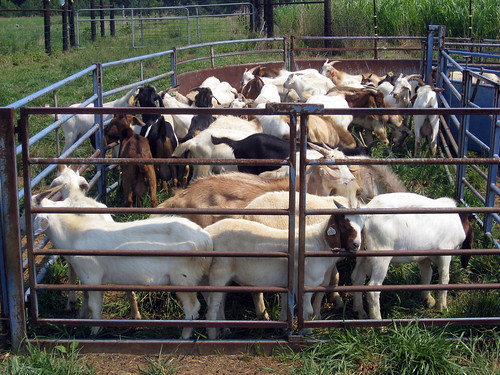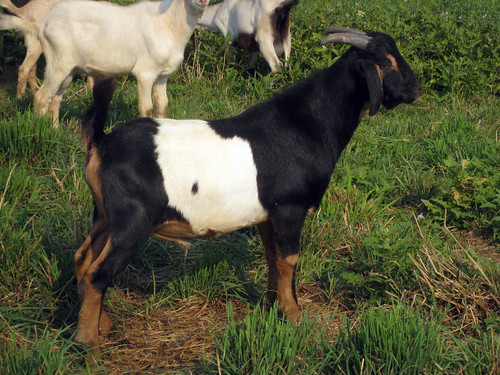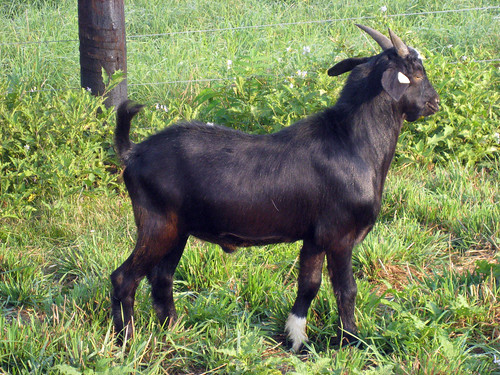They were weighed by Jeff Semler. FAMACHA© and body condition scores were determined by Susan Schoenian. Individual and pooled fecal samples were collected by Susan Schoenian and Shannon Uzelak. The health of all the goats was assessed and treatments were administered as deemed necessary.
 For the first time in this year's test, the goats posted meaningful gains. Average daily gain for the previous two weeks ranged from -0.60 to +0.533 lbs. per day and averaged 0.167 lbs. (75.8 g) per day. Only 8 goats lost weight.
For the first time in this year's test, the goats posted meaningful gains. Average daily gain for the previous two weeks ranged from -0.60 to +0.533 lbs. per day and averaged 0.167 lbs. (75.8 g) per day. Only 8 goats lost weight.Two goats tied for the top rate-of-gain for this weigh period: a Kiko buck consigned by Kendell Barnes (Kentucky) and another Kiko buck consigned by Terry Hankins (Mississippi). These goats gained 0.533 lbs. (241.8 g) per day from July 3 until July 18.
 Another Kiko goat consigned by Terry Hankins gained 0.467 lbs. (211.8 g) per day. Kiko crossbred bucks consigned by Bill Lowe (Pennsylvania) and Robie Robinson (Virginia) also posted gains of 0.467 lbs. per day.
Another Kiko goat consigned by Terry Hankins gained 0.467 lbs. (211.8 g) per day. Kiko crossbred bucks consigned by Bill Lowe (Pennsylvania) and Robie Robinson (Virginia) also posted gains of 0.467 lbs. per day.Average daily gain for the first 28 days of the test ranged from -0.444 to +0.444 lbs. per day and averaged 0.089 (40.4 g) per day. So far, the top gaining goat is one of Terry Hankin's Kikos. It is averaging 0.444 lbs. per day. For the first 28 days of the test, Terry's three bucks have gained an average of 0.345 lbs. (156.5 g) per day; 0.467 lbs. (211.8 g) per day since July 3.
 FAMACHA© scores improved from an average of 1.94 on July 3 to 1.70 today. Only two goats required deworming. Two goats had been dewormed since the last time the goats were worked. We were somewhat surprised that more goats didn't require anthelmintic treatment, as conditions are conducive to the barber pole worm life cycle and the last larva test showed that the barber pole worm comprised more than 90% of the worm infection.
FAMACHA© scores improved from an average of 1.94 on July 3 to 1.70 today. Only two goats required deworming. Two goats had been dewormed since the last time the goats were worked. We were somewhat surprised that more goats didn't require anthelmintic treatment, as conditions are conducive to the barber pole worm life cycle and the last larva test showed that the barber pole worm comprised more than 90% of the worm infection.Body condition scores remain relatively unchanged from week to week, but change significantly for some goats, especially those who experience weight loss. Some goats spend the majority of their time in the central laneway (near the shelters and shade structure) and do not go out to the paddocks for grazing.
 This is one reason why they may be losing weight. It also contributes to parasitism as grass in the laneway is probably more contaminated with feces and infective worm larvae than the forage in the grass paddocks.
This is one reason why they may be losing weight. It also contributes to parasitism as grass in the laneway is probably more contaminated with feces and infective worm larvae than the forage in the grass paddocks.Due to the height of the forage, goats grazing the pearl millet are not likely to get infected (or re-infected) with worm larvae. Goats grazing the chicory are also less likely to have parasite problems, as chicory is purported to have an "anthelmintic-like" effect on worm eggs and larvae.
 The heat index was high today, and warm, humid conditions are likely to prevail over the next several days. Next week, temperatures are predicted to drop into the mid and upper 80's. There is a chance (30%) of thunderstorms next Monday and Tuesday.
The heat index was high today, and warm, humid conditions are likely to prevail over the next several days. Next week, temperatures are predicted to drop into the mid and upper 80's. There is a chance (30%) of thunderstorms next Monday and Tuesday.The goats will be worked next on Friday, August 1. Individual and pooled fecal samples will continue to be collected, since only a few goats have required deworming since the test started.
Download July 18 report
View more pictures of test at Flickr™











